A guide to getting the barrel dimensions right and ordering sprinklers from different manufacturers
Dry sprinkler heads need barrels at sufficient lengths to avoid trapped, frozen water and manage the temperature transition between cold and heated spaces. Manufacturers custom-make these heads, so you’ve got to request the right specs to get the sprinkler you need.
This blog explains how to take these measurements for different manufacturers, plus reviews how dry sprinklers work, when they are needed, and how fire protection pros determine the right barrel length.
Read the entire piece—or feel free to skip down to learn how to take measurements:
- The purpose and applications of dry sprinklers
- How dry barrel heads work
- How much barrel length is enough? Installation-specific and NFPA 13 requirements
- How to measure the “A dimension,” etc. (barrel length) to order dry sprinkler heads
The purpose and applications of dry sprinkler heads
The term “dry sprinklers” can be slightly confusing for people not well-versed in fire protection.
Often, the term refers to dry pipe sprinkler systems, which have pressurized air or nitrogen in their pipes instead of water but sometimes use the same sprinkler heads employed in wet pipe systems. Dry pipe systems serve non-climate-controlled structures subject to cold temperatures, such as parking garages, so that water won’t freeze in the pipes.
However, dry sprinkler heads, also called dry barrel sprinklers, have supporting and specific applications:
- Dry sprinkler heads must be used for pendent or sidewall orientations within dry systems unless conditions are met to prevent water from getting trapped and freezing in the pipes supplying them. The measures include using “return bend” fittings and climate-controlling those sprinklers and pipe sections. (NFPA 13, 2022: Section 8.2.2.2)
- Dry heads in any orientation often protect specific areas of buildings with wet pipe systems that get cold. For example, a structure that needs sprinkler coverage of onsite freezers or an outside loading dock might use dry barrel sprinklers attached to a wet system.
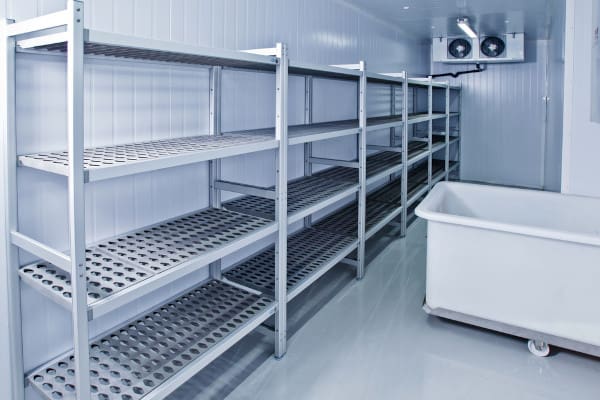
How dry sprinkler heads work
Dry sprinkler heads have evolved since the first UL-listed one appeared in 1937, but the basic principles remain the same.
They have a barrel between their fitting into the water supply pipe and the sprinkler head, and a seal at the supply end. The seal prevents water from entering the barrel and freezing, which can block operation. When a dry sprinkler is attached to a wet system, for example, the water stays in the climate-controlled supply pipe and only comes into play when the sprinkler activates.
When the heat from a fire causes a head’s temperature-sensitive bulb or link to break, it releases the pressure on a spring, opening the seal at the supply end and letting water flow into the barrel and out of the head.
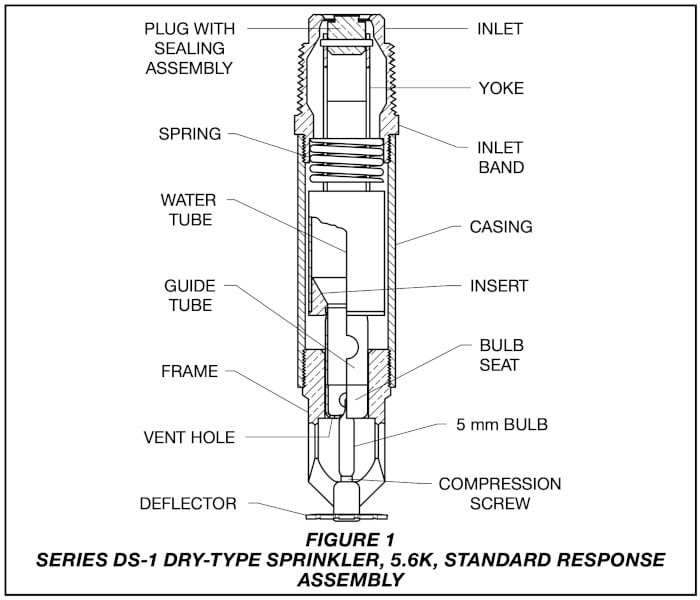
The barrel putting distance between the head and the supply pipe also serves crucial purposes:
- Limiting conduction, which is heat (energy) transfer between objects in direct contact—in this case, the supply pipe, barrel, and sprinkler head.
- Limiting convection, which is “the transfer of energy between a solid surface and a moving fluid.”
Conduction would pull heat from a climate-controlled supply pipe along the solid surfaces. Convection may occur when “windy conditions” around the sprinkler head “increase the rate of heat transfer” from a climate-controlled space. A long enough barrel between a cold sprinkler head and its warmer supply pipe can mitigate both effects.
How much barrel length is enough? Installation and NFPA 13 requirements
The length of the barrel between the dry head sprinkler and the supply pipe depends on two factors:
- The distance required between the static positions of the supply pipe and the sprinkler head
- The temperature the barrel will be exposed to between the colder space and its connection
Item number one is straightforward. For example, a climate-controlled supply pipe above a pendent sprinkler protecting a freezer in a big box store is in a specific position.
When an installer attaches the sealed end of the dry sprinkler to the supply pipe fitting, the barrel must be long enough to reach into a hole drilled into the freezer’s top, and the sprinkler must be in the appropriate position.
The second factor depends on what temperature the barrel will be exposed to above, below, or to the side of the colder area. NFPA 13: Standard for the Installation of Sprinkler Systems sets rules for how long dry sprinkler heads’ “exposed barrels” must be under different conditions:
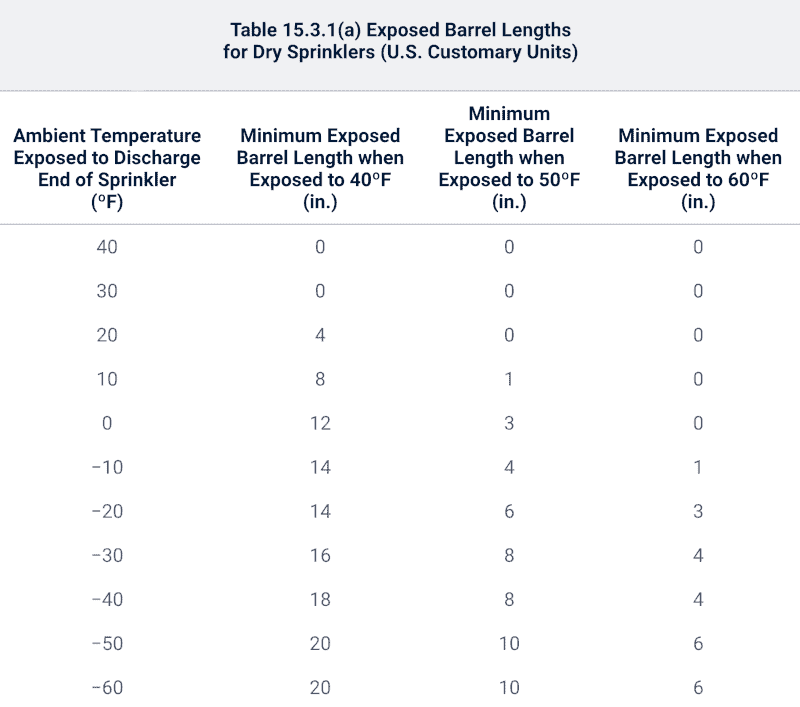
Continuing our big-box store example: Let’s assume the temperature around the dry sprinkler head inside the store’s freezer is -10°F. You’d find that number midway down the leftmost column: “ambient temperature exposed to discharge end of the sprinkler.”
The chart then provides three columns representing different scenarios. Let’s say someone is standing on top of the freezer, their feet placed next to the hole where the dry sprinkler’s barrel and head will project into it. If the ambient temperature that surrounds them—from the bottom of their feet to the supply pipe—is:
- 60°F, which is often the case in a climate-controlled space, then the exposed portion of the barrel above the entry point must only be a minimum of 1” long
- 50°F, then the exposed portion of the barrel must be at least 4”
- 40°F (the minimum temperature at which wet pipes must be maintained), then the exposed barrel must be at least 18”
Again, these minimum lengths can prevent conduction and convection from stealing heat from the climate-controlled space, freezing any leftover water in the barrel or the water in the supply pipe.
In many cases, the temperature the barrel is exposed to will easily be 60°F or higher since the barrel is in a climate-controlled space. However, many designers and installers opt for using lower-temperature thresholds and longer barrel lengths to be safe.
For example, maybe our hypothetical building owner lowers the store’s heat during off-hours, or a power outage strikes and causes the temperature to drop. In these cases, a longer barrel length that assumes the temperature falls to 40°F may come in handy, preventing or delaying freezing.
How to measure the “A dimension,” etc. (barrel length) to buy pendent, sidewall, and upright dry sprinkler heads
Sprinkler manufacturers need to know what barrel length a buyer needs to custom-make these heads.
Data sheets that manufacturers issue provide instructions on how to measure this distance, sometimes referring to it as the “A dimension,” the “ordering dimension,” “order lengths,” or, in one specific case, the “B dimension.”
Taking this measurement is pretty simple. But unfortunately, there are slight differences among some manufacturers, so you have to check the procedure on each data sheet.
Measuring Tyco or Reliable dry barrel lengths
Tyco and Reliable have the same basic rules for dry head sprinklers:
- Sprinklers installed with an escutcheon or cover plate: measure the ordering dimension from the face of the sprinkler fitting to the inside surface of the escutcheon/cover, which is the outer surface of the wall or ceiling. Round to the nearest 1/4″.
- Sprinklers without a cover or escutcheon: measure from the face of the sprinkler fitting to the end of the sprinkler deflector. Round to the nearest 1/4″ (sidewalls).
Note: Buyers may need to round up the measurements differently among different installation types, models, and orientations, and escutcheons and covers may have different installation adjustment ranges. So, check the specific data sheet and order form!
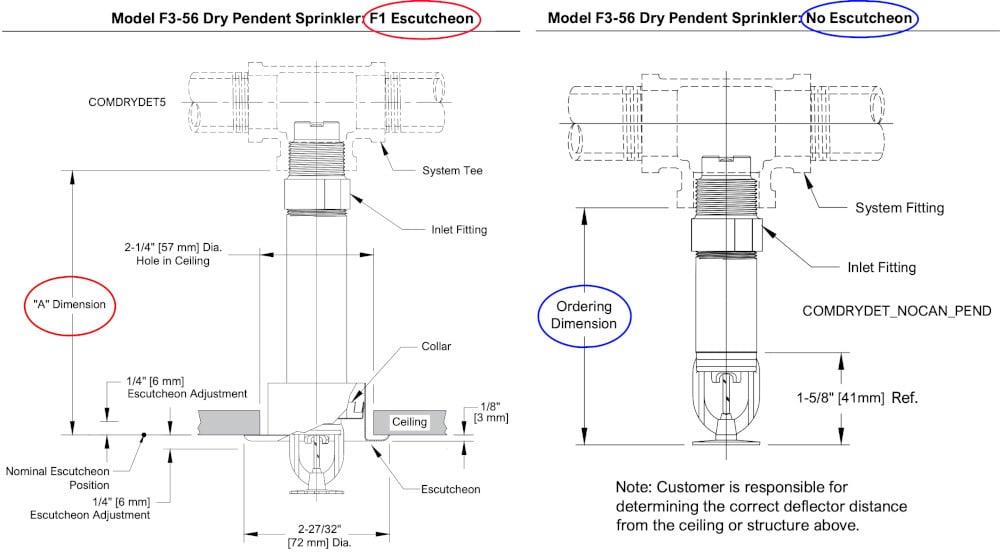
Measuring Victaulic dry barrel lengths
- Sprinklers installed with an escutcheon or cover plate: measure the ordering dimension from the face of the sprinkler fitting to the inside surface of the escutcheon, which is the outer surface of the wall or ceiling. Round to the nearest 1/4″ for V36 sprinklers and the nearest 1/8” for V33, V56, and V81 sprinklers.
- Sprinklers without a cover or escutcheon: Measure from the face of the sprinkler fitting (it’s about the middle of a grooved fitting) to the base of the sprinkler. (The latter endpoint differs from the Tyco and Reliable measurements mentioned above, which instead specify the top of the deflector.) Round to the nearest 1/4″ for V36 sprinklers and the nearest 1/8” for V33, V56, and V81 sprinklers.
Note: Buyers may need to round up the measurements differently among different installation types, models, and orientations, and escutcheons and covers may have different installation adjustment ranges. So, check the specific data sheet and order form!
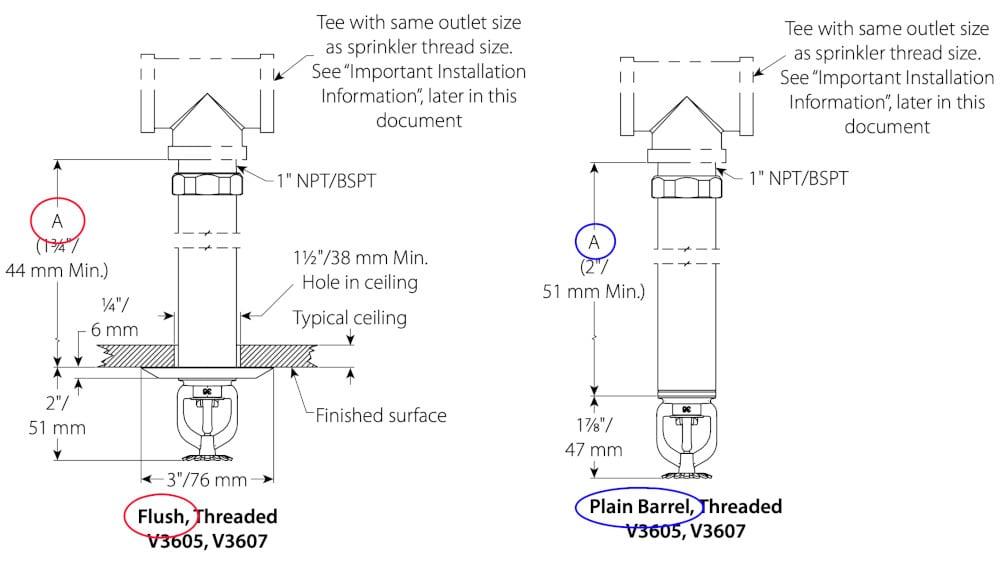
Victaulic also has a handy chart showing how these lengths adjust for installers who need to change an installation type in the field. For example, this table is on the datasheet for Victaulic’s V3605 and V3607 dry head sprinklers:

So, say that a plain barrel sprinkler is installed with a 30” barrel. If the building owner puts in some new ceilings and needs to install these sprinklers with a flush escutcheon, the barrel length would be 1/4″ shorter: 29-3/4.”
Measuring Viking dry barrel lengths
Viking’s measurements have a mix of some of the above rules—but things change with upright sprinklers:
- Sprinklers installed with an escutcheon or cover plate: measure the ordering dimension from the face of the sprinkler fitting to the inside surface of the escutcheon/cover, which is the outer surface of the wall or ceiling. Round up to the nearest 1/4″ for lengths between lengths of 3-1/4″ and 47-1/2” (escutcheons) or 4” and 48-1/4” (covers).
- Pendent and sidewall sprinklers without a cover or escutcheon (“plain barrel”): measure from the face of the sprinkler fitting to the base of the sprinkler. Round up to the next higher 1/2” increment between 3” and 47”.
- Upright sprinklers: measure from the face of the sprinkler fitting to the end of the sprinkler deflector. Uniquely, Viking refers to this measurement for uprights as the “B dimension.” Round up to the nearest 1/2″ increment between 3” and 48-1/2”.
Note: Buyers may need to round up the measurements differently among different installation types, models, and orientations, and escutcheons and covers may have different installation adjustment ranges. So, check the specific data sheet and order form!
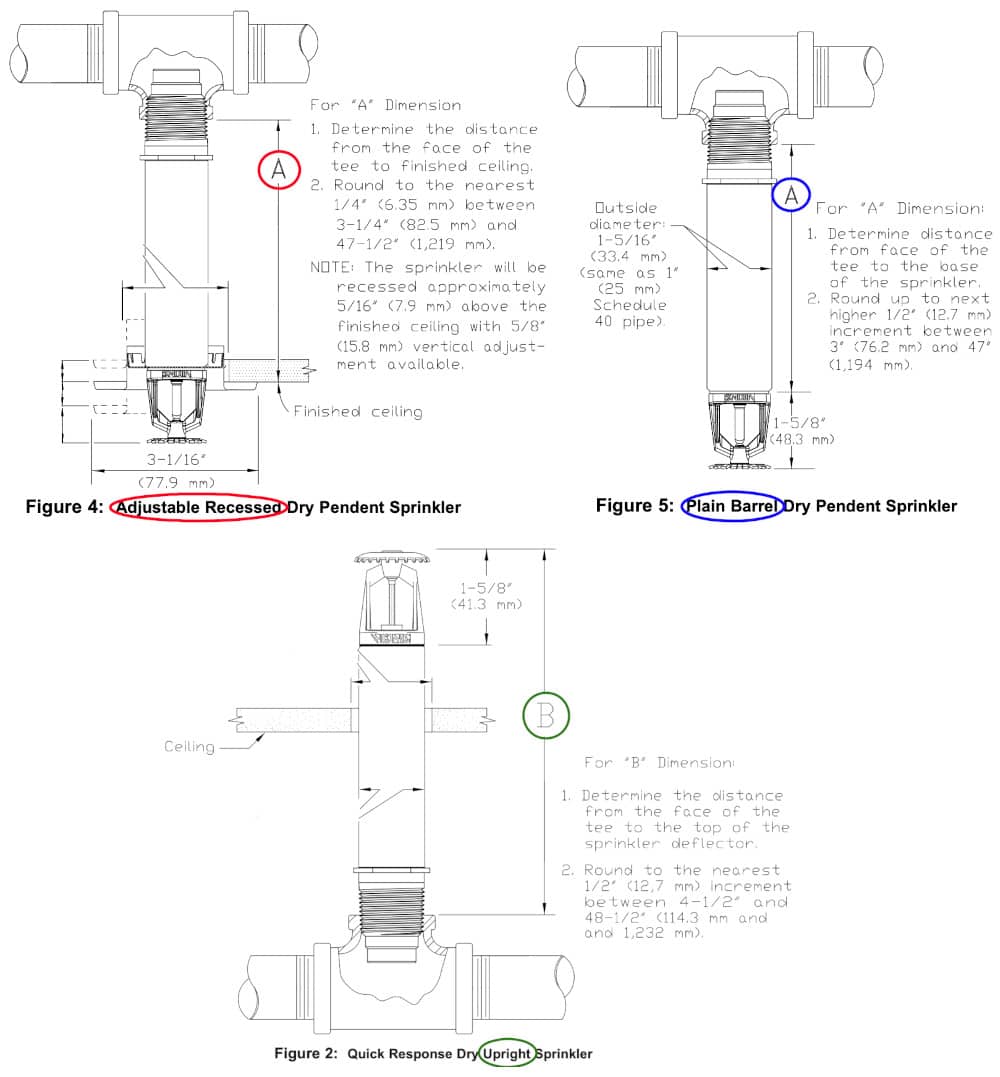
Check the data sheets before ordering dry barrel sprinklers!
Sprinkler manufacturers have slight differences in measuring the number you give them when ordering—and procedures always have the potential to change from what is covered above.
So, always consult the definitive source: the current data sheet for a specific sprinkler. These documents have all the information to determine the length plus the finish, any required accessories, and more.
QRFS offers dry barrel sprinklers on special order, and we can help you navigate the process of buying the ones you need. Contact us at support@qrfs.com or 888-361-6662 with any questions or to place an order!
This blog was originally posted at blog.qrfs.com. If this article helped you, check us out at Facebook.com/QuickResponseFireSupply or on Twitter @QuickResponseFS.


